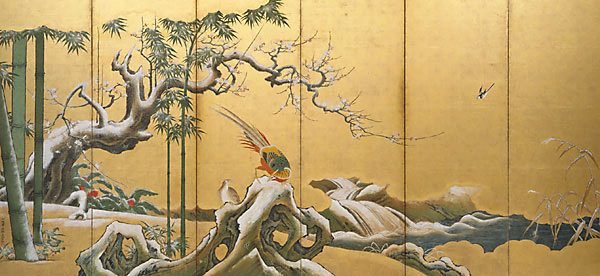

-
Details
- Other Titles
- Cypress and plum blossom
Pine and plum blossom - Place where the work was made
-
Japan
- Period
- Edo (Tokugawa) period 1615 - 1868 → Japan
- Date
- 17th century
- Media categories
- Screen , Painting
- Materials used
- pair of six-panel screens (byobu); colour and gold on paper
- Dimensions
-
a - right screen - cyrpress and pine, 167 x 359.5 cm
a - right screen - cyrpress and pine, 182.5 x 376 cm
b - left screen - plum blossom and bamboo, 167 x 359.5 cm
b - left screen - plum blossom and bamboo, 182.5 x 376 cm
- Signature & date
a. Signed l.l., in Japanese, ink "...Kano Eino... [& artist's seal]". Not dated. [left screen]
b. Signed l.r., in Japanese, ink "...Kano Eino... [& artist's seal]". Not dated. [right screen]- Credit
- Art Gallery of New South Wales Foundation Purchase 1994
- Location
- Not on display
- Accession number
- 638.1994.a-b
- Copyright
- Artist information
-
Kanō Einō
Works in the collection
- Share
-
-
About
These screens were painted by Kanō Einō, the third-generation head of the Kyoto Kanō school. Kanō artists were often commissioned to create lavish gold screens for the elite samurai class, who sought to display their wealth and power.
The cypress was a favoured symbol of samurai dominance, while the pierced rock formation is a Chinese Daoist interpretation of the yin and yang, void and form. The combination of the pine, bamboo and plum blossom on the far left originated in China in the 1200s and is known as the ‘three friends of winter’. The pine exemplifies steadfastness and courage, the bamboo uprightness and the plum blossom, purity. The pheasant is a Chinese emblem of beauty and good fortune, but in Japan the bird was also prey in the samurai sport of falconry.
-
Places
Where the work was made
Japan
-
Exhibition history
Shown in 3 exhibitions
The art of Japanese screen painting, Art Gallery of New South Wales, Sydney, 06 Nov 2004–06 Feb 2005
Conversations through the Asian collections, Art Gallery of New South Wales, Sydney, 25 Oct 2014–13 Mar 2016
In one drop of water, Art Gallery of New South Wales, Sydney, 15 Jun 2019–21 Feb 2021
-
Bibliography
Referenced in 7 publications
-
Edmund Capon AM, OBE, Art Gallery of New South Wales: highlights from the collection, Sydney, 2008, 176 (colour illus.), 177 (colour illus.). The colour illus. on page 177 is a detail of this work.
-
Edmund Capon AM, OBE, Art Gallery of New South Wales Foundation Annual Report 1997, Sydney, 1997, cover (colour illus.), 20 (colour illus.).
-
Edmund Capon, Orientations, 'Asian Collections in the Art Gallery of New South Wales', pg. 76-79, Hong Kong, Sep 2000, 78 (colour illus.). fig.4
-
Bruce James, Art Gallery of New South Wales handbook, 'Asian Collection: East Asia', pg. 246-287, Sydney, 1999, 273 (colour illus.).
-
Jackie Menzies (Editor), The Asian Collections Art Gallery of New South Wales, 'The World of Samurai Culture', Sydney, 2003, 218, 219 (colour illus.).
-
Clare Pollard, Look, 'The Folding Screen', pg. 19, Sydney, Nov 2004, 19 (colour illus.). Image is part a of the screen only
-
Michael Wardell, Look, 'Foundation building', pg.14-17, Sydney, Sep 2004, 17.
-
